
What is a bearded dragon?
Before deep diving into our Ultimate Guide To Raising And Caring For a Bearded Dragon, let’s start by understanding what a beardie is.
Bearded dragons are members of the lizard family Agamidae. There are more than 350 species in this family. They are known under a wide range of common names such as chisel-toothed lizards, dragons, and pricklenapes [1].
The bearded dragon is an increasingly popular lizard among reptile enthusiasts, and for good reason. One of the main reasons is that it is relatively strong and easy to keep in captivity.
Furthermore, the beardie is fairly calm and rarely tends to bite or scratch.
The bearded dragon is primarily native to the Australian continent and has a semi-arboreal existence. It lives in quite varied habitats, from deserts to forests, going to brushy lands (savannas).
Note: Australia has very restrictive export laws regarding its wildlife, so specimens found on the market are very often from captive breeding.
It spends most of the morning and late afternoon looking for food, while it is mostly hidden during the hottest part of the day.
Another cool element is that the bearded dragon will never get too big. Plus, his social temperament makes him a good pet.
Is a Bearded Dragon a Lizard?
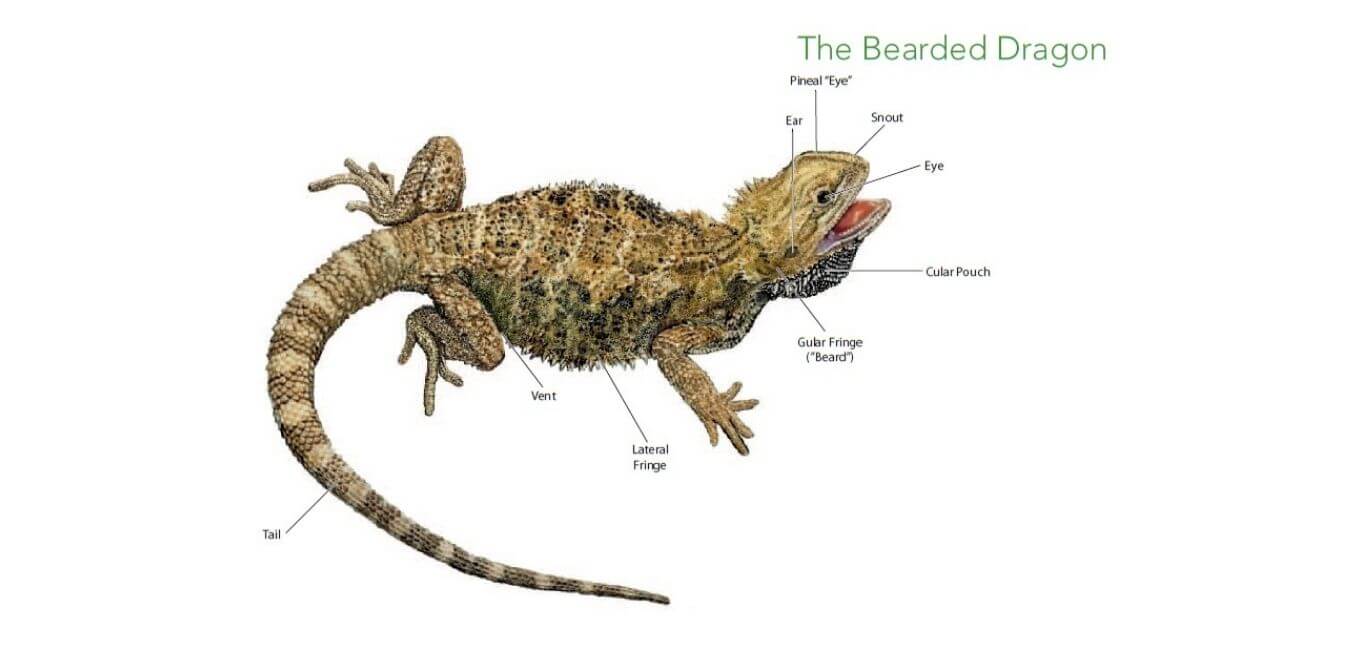
Image credit: Steve Grenard, Bearded Dragon book
Yes medium-sized, the bearded dragon is a sturdy and massive lizard supported by strong limbs equipped with sharp claws.
It has a large triangular head and a row of thorny scales under the neck which serves as a warning against predators.
When it feels threatened, the beardie opens its mouth wide while deploying its beard of thorns in order to impress its enemies.
Unlike females, males, which are generally larger in size, have several distinct femoral pores located on the inside of the thighs.
Furthermore, bulges on either side of the tail are visible in males. These bulges, which are actually the reproductive organs of males, are absent in females.
At birth, the bearded dragon measures roughly three inches (about 8 cm). Young bearded dragons usually begin to show their typical coloring, either grayish or beige, around the age of two or three months.
Interesting fact: there is a species very similar to the beardie. Called by its common name Lawson’s Dragon, the Pogona henrylawsoni (Well & Wellington, 1985) has a morphology almost identical to its cousin the Pogona vitticeps. On the other hand, being rather terrestrial, the tail and the limbs of Lawson’s dragon are shorter.
It also has a shorter, less triangular head and a less flat body. It should also be noted that the beard of this one is much less developed, even almost non-existent.
Bearded Dragon Types

According to Steve, in his book, Bearded Dragon, there are height types of beardies.
The scientific genus of bearded dragons is Pogona from the Greek word Pogon which means “beard”.
This list shows the name of scientists who first identified a specific type with the year of their discovery.
- Eastern bearded dragon, Pogona barbata (Cuvier, 1829)
- Dwarf bearded dragon, Pogona minor (Sternfeld, 1919)
- Inland or central bearded dragon, Pogona vitticeps (Ahl, 1926)
- Western bearded dragon, Pogona minima (Loveridge, 1933)
- Small-scaled or Drysdale River bearded dragon, Pogona microlepidota (Glauert, 1952)
- Mitchell’s northwest bearded dragon, Pogona mitchelli (Badham, 1976)
- Nullabor bearded dragon, Pogona nullabor (Badham, 1976)
- Rankin’s or Lawson’s bearded dragon, Pogona henrylawsoni (Wells and Wellington, 1985)
How Long Does a Bearded Dragon Live?
In captivity, this lizard can live about 8 years, although several cases of specimens having lived 10 to 12 years are recorded.
Note that most females very rarely exceed 8 years since they undergo several egg-laying during their life, which weakens them considerably.
Is a Bearded Dragon a Good Pet?
The bearded dragon is a docile reptile that you can handle and is suitable for beginners as well as for the more experienced.
Furthermore, it is a reptile that is active during the day, so it is easy to observe and maintain. In short, the pogona is a very good pet.
How to Choose Your Bearded Dragon
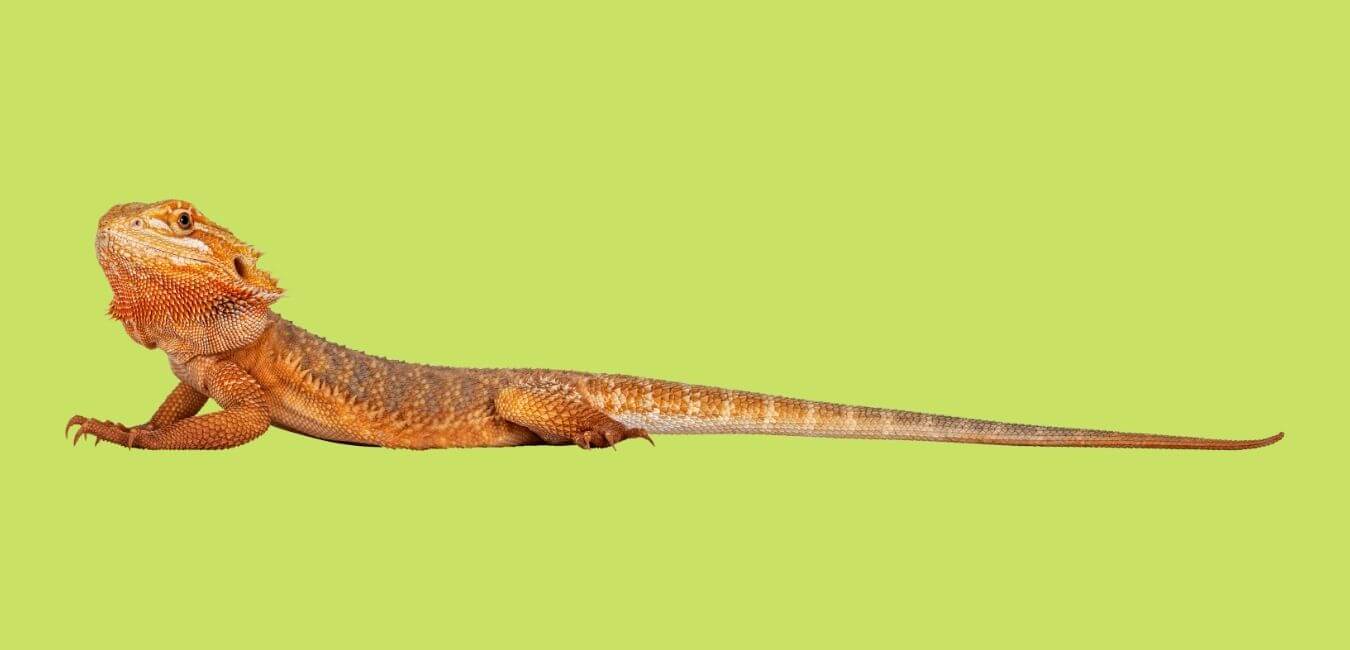
The excitement of having a new pogona can make us want to take any if I may say so. What I think is normal.
However, there are certain rules to observe. When I say rules, they are more points to consider.
Let me list them for you:
First, a juvenile can be bought after a month (10 to 15 cm) but beware, in the pogona family juvenile mortality rate is high.
This is the reason why I advise you to buy your beardie at the age of 2 and a half months.
Males and females are identical. That is to say that a female can be as massive as a male.
As a very general rule, males are larger, have a wider head and base of the tail. Note that females and males both have femoral pores on the inner side of the thighs. It will be impossible for you to visually know if your pogona is a female or a male.
How To Take a Healthy Beardie Home
Here are some signs of a healthy beardie:
- Active
- Eyes wide open and clear
- No missing toes on all four feet
- Full tail
- Normal coloration
- Clean physical appearance (no deformation)
- Tip of tail not black (black tip could indicate that the animal is sick or a sign of necrosis)
- The pogona is a lizard which must be fleshy and stocky (less visible on a juvenile)
Tip: Look for a fat baby beardie who runs off when you prod it.
Second are the tastes and colors concerning their mutation. To make it simple and without going into details, you can very well take a pogona of yellow – red – white color etc ..
Ask for as much proof as possible to justify the mutation as well as the origin of the parents.
This will be extremely important in the event of future reproduction. We cannot reproduce certain mutations between them, especially in zeros.
I totally advise against going on a silkback. I am against this phase.
You are also free to go either for a juvenile or an adult.
Note: There is a technique that breeders practice to determine the sex of even juvenile pogona. This consists of raising the tail of the pogona at 90 ° then using a powerful illuminating lamp to observe the genitals. It’s kind of like an x-ray.
Is it Hard to Take Care of a Bearded Dragon?
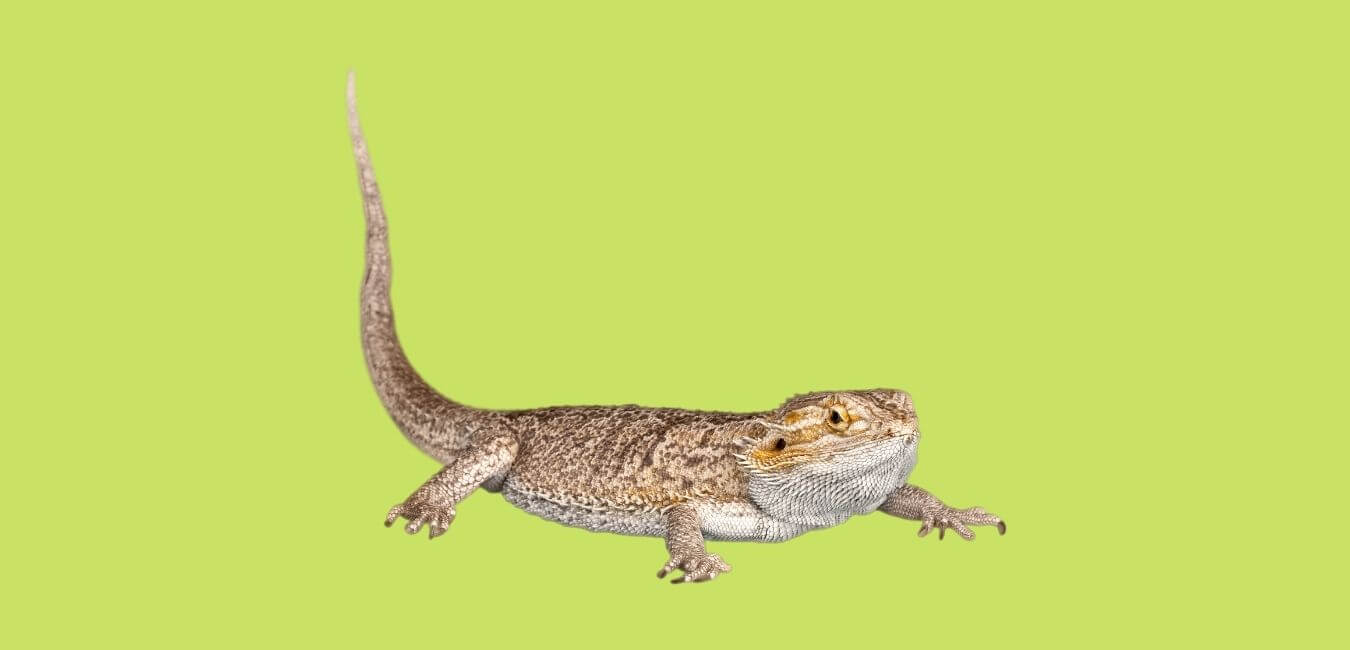
No it is not hard to take care of a bearded dragon but depending on their age there are few things you need to consider.
Juvenile Pros
You will have the pleasure to see it evolve. It will also be easier to get him used to plants even though they are not too focused on it at the beginning.
Your juvenile beardie will also be used to you from a very young age and therefore it will facilitate handling if necessary.
Juvenile Cons
Higher mortality rate than in adults. They are also more prone to dehydration and require a lot more attention and presence.
Regarding food, they are real little gluttonous. They can easily eat a good twenty or even twenty five crickets per day. Therefore, there is a financial aspect that should not be overlooked.
Adult Pros
They require less attention if I may say so and are more resistant than the juveniles (which seems normal).
When it comes to the number of bugs, they also eat a lot less and can go without eating for a few days.
Cons of choosing adults
It is the cross and the banner to make them eat vegetables if they have not been used from a very young age. There is no pleasure to see them grow up. They are fiercer to manipulation.
Note: Some will tell you that a juvenile pogona needs a smaller terrarium than an adult. Not wrong yes, but you might as well go for a large terra immediately. This will avoid having to buy additional hardware later.
Very important
Can you put 2 bearded dragons in the same tank?
There is a rule in terrariums, namely 1 pogona per terrarium. Honestly, this is very important because sooner or later it will cause you big problems.
Male and male together = Deathmatch
Male and female = Constant reproduction and relentlessness of the male on the female therefore exhaustion.
Female and female = One day or the other it will end badly.
Male and female should only be together if there is reproduction and after having carried out the “brumation” period and if they are in perfect health.
They are solitary reptiles, they don’t need to be together in the same terrarium, it is just a selfish human need to want this.
Bearded dragons won’t be happier together.
Furthermore, it is impossible to make different species of pogona coexist. They would fight.
Another important thing, if you have a pogona say 8 months old and you want to acquire a 2-month beardie, this will pose a serious problem.
It is necessary to associate specimens of similar size to avoid the risks of cannibalism.
Please don’t make the mistake of putting 2 beardies in the same terrarium. You won’t get anything good in the end.
Where to Buy a Bearded Dragon
The best place to buy your beardie is from a trusted private breeder. You can find breeders through your local reptile businesses, fan groups or even reptiles expos.
Furthermore, you can find beardies on the net by searching for key phrases such as “bearded dragon breeder” or “bearded dragon prices”.
Pet Stores are also another option. This gives you the opportunity to closely examine your lizard before you buy it.
Recommended Reading: How much are bearded dragons?
Bearded Dragon Diet
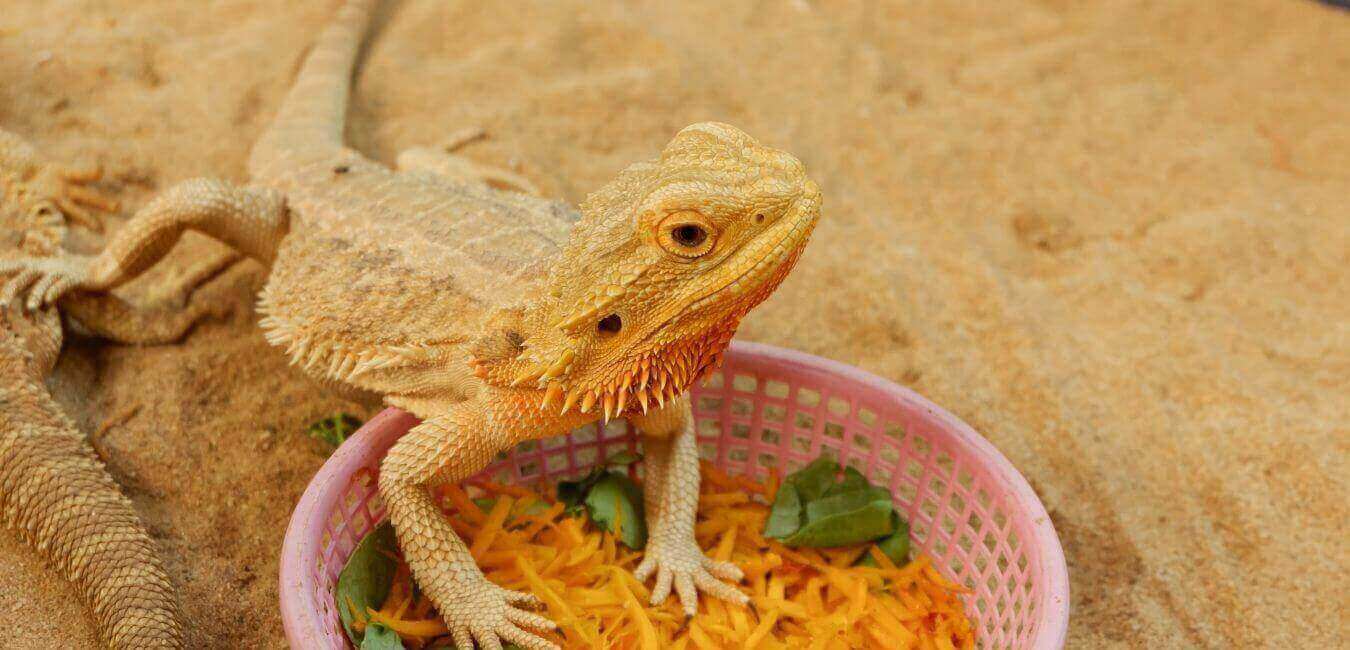
You need to feed and give fresh water to your beardie every day, if possible. In fact, some pet owners feed their bearded dragon two to three times a day.
These lizards are easy to please so to speak as they eat almost everything. They are omnivorous meaning that they eat both animal and vegetable matter [2]. Moreover, they eat leaves (foliovorous), fruits (frugivorous) and insects (insectivorous).
A good diversified diet is essential to your beardies’ health. It is therefore strongly recommended to feed them with well-balanced foods of the highest quality.
This is more important in the case of young bearded dragons, as they grow incredibly fast. This is a lizard that eats a lot, so it should not be deprived of food.
Insects
To do this, it is advisable to feed insects, such as crickets, earwigs, cockroaches and worms, by mixing them with foods rich in calcium before offering them to your reptile.
It is also possible to sprinkle the insects with calcium supplements at least twice a week to obtain a supply twice as high in calcium as in phosphorus.
For young specimens, meals should consist of insects of suitable size daily. As it grows, the bearded dragon will readily accept small mice. These are both rich and well balanced, which makes them a very good food.
Beardies will eat a wide range of insects. Collecting insects directly from nature is possible.
On the other hand, it is necessary to avoid capturing insects which could have been in contact with certain harmful products such as pesticides and insecticides.
To be on the safe side, simply purchase these insects commercially.
Note: Attention! It is strongly recommended not to feed them fireflies, caterpillars, or butterflies.
The toxicity of some species can be very harmful to reptiles.
What insects can Bearded Dragons Eat?
Here are some of the questions you may be asking yourself:
- Can bearded dragons eat katydids?
- Do beardies eat earwigs?
- Can bearded dragons eat islander roaches?
- Do bearded dragons eat isopods?
- Can Bearded Dragons Eat Jicama? (Benefits)
Fruits and Vegetables
Although the diet of young lizards consists mainly of animal foods, it is also important to offer them, once every two days, some vegetables cut into small pieces.
The plants most frequently offered in captivity to bearded dragons are mainly green lettuce, chicory, alfalfa, carrot, mango, squash, endive, fig, as well as dandelion and clover. Recommended fruits include most varieties of berries, apples, and pears.
Diversifying foods is essential to avoid voluntary deficiencies or anorexia caused by food fatigue.
Adult or advanced juvenile beardies should preferably be fed plants at about 80% of their diet. Indeed, it seems that offering food too rich in animal protein to lizards of an older age can cause serious liver disorders.
Fruits and Vegetables Bearded Dragons Can Eat
On the fruits and vegetables side, beardie owners often wonder:
- Can bearded dragons eat violets?
- Wondering if bearded dragons can eat pumpkin puree?
- Can bearded dragons eat italian parsley?
- Will bearded dragons eat unsweetened applesauce?
- Do bearded dragons eat zucchini squash?
- Would bearded dragons eat yellow squash?
- Can bearded dragons eat jicama?
- Do bearded dragons eat yellow peppers?
- Wondering if bearded dragons quinoa?
- Can bearded dragons eat kale everyday?
- Asking yourself if bearded dragons eat yams?
Commercial lizards food
A wide range of manufacturers have developed foods for beardies. There has been mix messages on these foods.
Indeed, some beardie owners confirmed that their pets love pelleted foods while others reported that their dragons won’t have them.
We recommend not relying only on commercial food.
Bearded Dragon Habitats or Enclosures
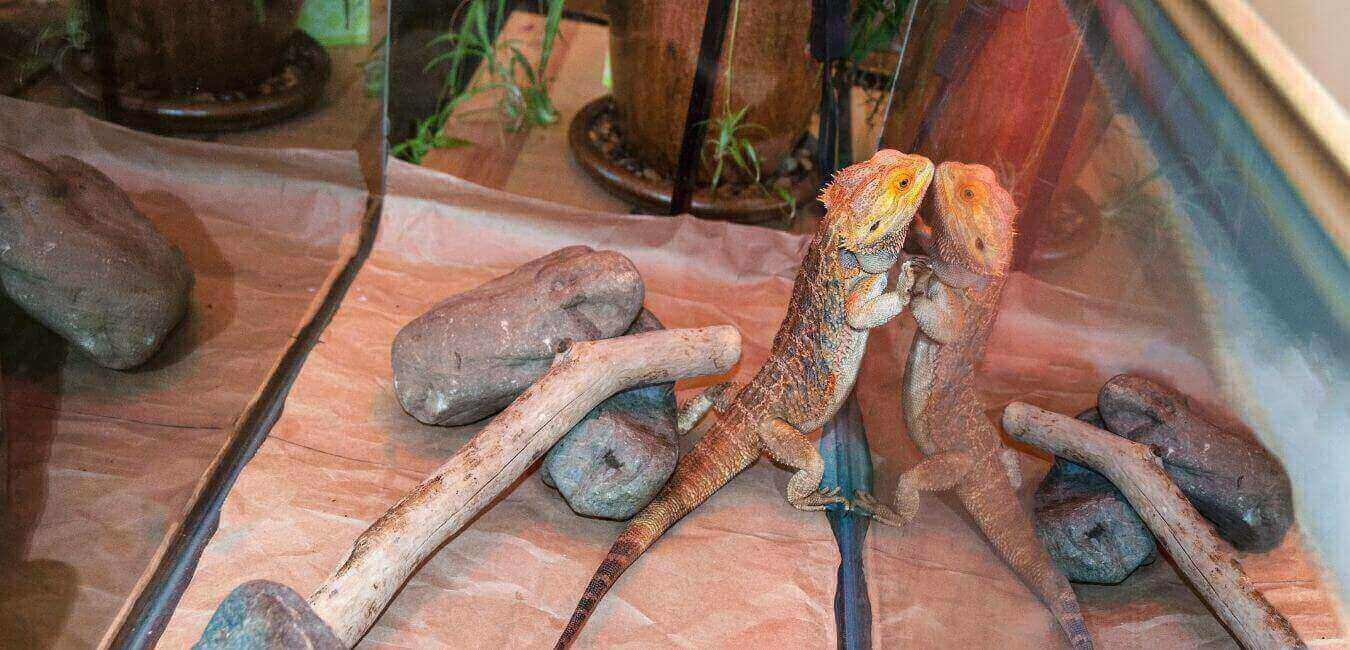
The beardie seems to have no fear towards humans, with a few exceptions, even when it is a juvenile specimen.
This behavior is quite unique to this species, as most reptiles usually exhibit an instinctive fear of humans.
Although a young bearded dragon can live in a relatively small vivarium, it is strongly recommended that an adult specimen be offered a large terrarium.
Terrarium Size and maintenance
Considering the stoutness of this lizard, the depth of the habitat should be at least 18 inches.
Therefore, a terrarium 48 inches (122cm) wide, by 18 inches (45cm) deep, by 18 inches (45cm) high is the minimum for keeping a couple in captivity.
Note that under no circumstances should more than one male cohabit together, because the territorial fights are very violent.
The bottom of the vivarium can be covered with fine sand or wood bark, which greatly facilitates maintenance.
Indeed, when the reptile defecates, it is possible to pick up only the soiled part without undoing the entire decor.
Note: This substrate must be changed every two or three months to ensure good hygiene and good health for the animals.
For young specimens, it is strongly advised to use a felt mat or absorbent paper to cover the bottom of the vivarium, as these are more prone to intestinal obstruction.
On the other hand, this substrate must be cleaned and / or changed weekly, because it greatly promotes the proliferation of odors and bacteria.
Enclosure and lighting
The temperature should be maintained between 28 and 35 ° C during the day and oscillate around 22 ° C at night.
Since the Bearded Dragon is a diurnal reptile, good quality UVB light, placed so that it is not separated from the animal by glass, is important.
Otherwise, the glass will block the rays and the neon would therefore be of no use.
For greater efficiency, the neon must be placed so that the occupant can approach it within 30cm without being able to reach it.
UVB rays are essential for the health of the lizard in order to allow it to properly assimilate vitamin D during its meals.
In order to get the ideal temperatures, a heated light placed over a rock or branch is important.
A heating film under the vivarium can also be installed opposite the heating light, to allow the reptile to digest well after a meal.
Several massive branches should be arranged so that the animal can climb and approach heat sources while keeping a certain safe distance so as not to get burned.
Although the Bearded Dragon hydrates by eating plants, a bowl of water kept clean and changed every other day is recommended to allow the lizard to drink when needed.
It is also possible to spray the plants with water, which will allow better hydration of the animal if it does not drink voluntarily.
Bearded Dragon Breeding
Bearded dragons are sexually mature around the age of one and a half to two years.
To increase the chances of reproduction, a rest period of about two months is important before mating bearded dragons.
During this period, the temperature should gradually decrease until it oscillates around 24 to 27 ° C during the day and 18 to 20 ° C at night.
The lighting duration should also decrease from 10-12 hours per day to about 8 hours. It should be noted that during this period, most of the specimens refuse to feed.
About two months later, the heat of the vivarium should increase at the rate of a few degrees per day until normal temperatures are reached.
It is strongly recommended to separate male and female to allow the latter to regain its strength during meals.
Then, let two weeks pass and then put the couple back together. The male will then perform a courtship display which consists of deploying his black beard while nodding his head vertically in a repetitive manner.
Then, the male grabs the back of the female’s neck while clawing her with his hind legs to force her to mate. If the female is receptive, she will lift the tail to allow mating.
If the female is not interested, she will simply tackle the ground to prevent reproduction. Mating takes about two to three minutes.
Bearded Dragon Health
Burns caused by heating elements in direct contact with the bearded dragon. Example: heating rocks in the terrarium, or heating lamps accessible to the animal.
- Vitamin and calcium deficiency and lack of exposure to neon UVA-UVB
- Dermatitis
- Reproductive problem
- Impaction caused by ingested sand
- Intestinal parasites
As with all other animals, a purchase examination by an Anima-Plus veterinarian and then an annual examination is recommended.
A little note about salmonellosis… because if you have a reptile, you have probably already heard of it.
First, know that salmonellosis is a zoonosis, meaning it is a bacterium that can be transmitted from an animal to a human. In the case of Salmonella, it can be caught in a variety of ways.
Among these, there is by chicken meat, by aquarium fish, turtles and finally by other reptiles in general.
The people most at risk are children, the elderly or those who are sick. Possible symptoms in humans are diarrhea, fever, nausea, etc.
To avoid the contagion of this bacterium, it is therefore recommended to observe basic hygiene rules: you should be careful with handling uncooked meats, when washing aquariums or terrariums (do not do it in the bathroom or kitchen), and more your contact with animals such as reptiles of course, but also with mammals and birds can also be carriers of this bacterium.
Hand washing (before and after any handling) is in our opinion the best applicable prevention. By cleaning and disinfecting regularly, you will greatly reduce the risks associated with this bacterium.
Recommended Reading
Can bearded dragons eat kale everyday?
Bearded Dragons Diet Ultimate Guide
Bearded Dragons Behavior Ultimate Guide
Bearded Dragons Terrarium Ultimate Guide
Bearded Dragons Diseases and Health Issues: Your Ultimate Guide
